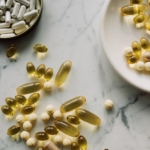“The doctors of the future will no longer treat the human frame with drugs, but rather will cure and prevent disease with nutrition.”
Thomas Edison February 11, 1847 – October 18, 1931
This next article in the foundation series will talk about fats in nutrition. Fats cover several substances that we get when we eat food, so there are many different types of fat. This is sometimes confusing to understand, and we aim in this article to tell you why fats are essential, the different types of fats and some strategies with fats in the diet.
Consumer confusion with fats is understandable; the science has been back and forth over the past few decades as to which fats are best or if we need to have fats at all. The latest research and consensus is we do need fats for a range of health benefits, but we need to know what products to buy and eat.
What are fats, and why do we need them?
Fats are a ‘macronutrient’, meaning they are an essential nutrient and prominent component of the diet; fats are a rich source of energy as they provide 9 calories per 1 gram of fat, so they are a very calorie-dense food.
Also, the cells of your body have a membrane lining them, and this membrane controls what goes in and out of the cells; this is made up of fats! Fats can also transport fat-soluble vitamins through the body, so specific vitamins (A, D, E and K) can be absorbed into fats and then transported to where they work in the body (1). This shows that getting enough healthy fat in the diet is essential to prevent nutrient deficiencies.
Fats also affect hormones because some hormones in the body are composed of fats and cholesterol. Cholesterol is what estrogen and testosterone are formed. So if you are under-consuming fats, you are potentially missing out on good hormonal balance.
Good Sources of fats include:
- Nuts
- Seeds
- Oily fish (e.g. salmon)
- Oils (e.g. light and virgin olive oil or coconut, not vegetable oils)
- Avocado
- Butter
- Gee
- Eggs
The Myths of Fats
It is a myth that fats make you gain fat. Fats are part of a well-rounded nutrition plan. Overeating and being under-moving is the cause of fat gain. Though with 9 calories per 1 gram of fat, fats are highly calorie-dense and therefore, overeating fats is something to be mindful of. For comparison, carbs and protein are 4 calories per 1 gram.
Many people also choose the low-fat option in supermarkets, but this is not necessarily the healthiest option, often low fat is substituted with extra carbohydrates and sugars. Our previous article on nutrition covers what is best to eat from each macronutrient food group. But do not instinctively believe that low fat is beneficial.
Types of Fat
Without getting into too much detail on the chemistry, there are 4 main categories of fats:
Saturated Fats:
- These are naturally occurring fats such as butter, eggs, and fats from animal meats. They are essential for the body and helpline cells and form hormones. In the past, they have been demonised, whereas, in more recent times, research has found them to be perfectly fine and healthy when consumed moderately. One of the most beneficial fats you can consume.
Monounsaturated:
- These are also naturally occurring; they mostly come from plants, olives, seeds and nuts. They help the mitochondria with energy production, help insulin function to control blood sugars and contain plenty of antioxidants to protect cell damage.
Polyunsaturated:
- These are your omega 3’s and omega 6’s; we need to get more omega 3’s in the Western diet as they are typically under-consumed. Omega 3’s have many benefits, including reduced inflammation and helping to protect the brain and eye tissue.
Trans fats:
-
These are the least healthy fat and pose risks for coronary heart disease and metabolic issues (3). They typically come from canola oil, soybean oil, corn oil or hydrogenated products such as margarine. So best to avoid these as much as possible.
A Strategy to Get Lean By Using Fats in the Diet
On a lower carbohydrate diet, it is an excellent strategy to use ‘rotation’ of fats; this involves 3 days of eating a regular amount of fats, and then the 4th day consuming more fats. This would look something like this:
- Days 1-3 = a tablespoon of oil at each main meal
- Day 4 = three tablespoons of oil at each meal
Oils are easy to measure using a tablespoon, and some good options include avocado oil, coconut oil, olive oil and butter.
How Much Fat Do You Need and When?
To help guide and baseline you with your nutrition in daily life, fats can be thought of as approximately 30% of your daily calories should come from fats, so for a 2000 calorie diet, this is 600 calories of fat which is about 65 grams of fat consumption per day.
Fats are great to include at the start of the day in addition to protein; this is because they will help to upregulate Acetylcholine which is a neurotransmitter (a chemical messenger in the nervous system) which is a prerequisite for speed, mental and physical speed, and is crucial for muscle contraction.
Acetylcholine regulates mental strength & energy and ensures that energy & information flow easily through every system in the brain. This alone is enough reason to have Fats in your diet. Fats can be a longer-lasting energy source perfect to start your morning, and towards the end of the day, fats can be reduced.
Conclusion
Fats are an essential part of your nutrition, so don’t be fooled into thinking they make you fat or unhealthy; by using the information in this article, you can be more guided into what makes certain fats healthy and what sources of food they come from.
Consultations
We’re always here to help. If you have any questions or would like advice about supplements, nutrition, or training, please book in for a consultation.
Disclaimer
Always speak with your physician or other healthcare professionals before making any nutritional & lifestyle changes or before taking any nutritional supplement. For more information, please view our terms & conditions.
References and Reading
- The Functions of Fats in the Body:
- The Essential Guide To Healthy Fat | Tips
- Health effects of trans fatty acids | The American Journal of Clinical Nutrition
- A healthy approach to dietary fats: understanding the science and taking action to reduce consumer confusion
- The Link Between Healthy Fats and Balanced Hormones



